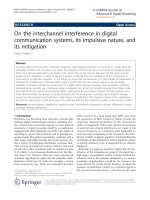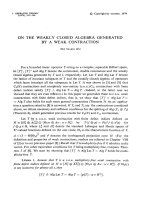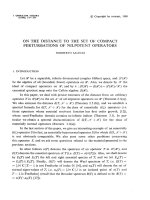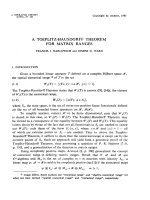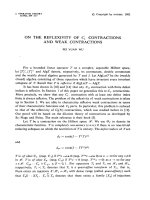Báo cáo toán học: " On the Symmetric and Rees Algebras of Some Binomial Ideals" pdf
Bạn đang xem bản rút gọn của tài liệu. Xem và tải ngay bản đầy đủ của tài liệu tại đây (128.01 KB, 8 trang )
Vietnam Journal of Mathematics 34:1 (2006) 63–70
On the Symmetric and Rees Algebras
of Some Binomial Ideals
Ha Minh Lam
1
and Morales Marcel
1,2
1
Universit´edeGrenobleI,InstitutFourier,
URA 188, B.P.74, 38402 Saint-Martin D’H`eres Cedex, France
2
IUFM de Lyon, 5 rue Anselme, 69317 Lyon Cedex, France
Received April 18, 2005
Revised September 5, 2005
Abstract. We give an explicit form of the presentation ideal of the Rees algebra and
a primary decomposition of the presentation ideal of the Symmetric algebra for some
binomial ideals generated by four elements, without any assumption on the fi niteness
and the characteristic of the ground field.
Introduction
In this paper we consider a binomial ideal I in the polynomial ring K[x
1
,x
2
,
,x
n
], minimally generated by four binomials, such that each binomial is a
difference of monomials without common factors. Codimension 2 lattice ideals
generated by four elements are a particular case. We study the Rees algebra and
the Symmetric algebra associated to I.
The Rees algebra R(I)ofI is defined to be the graded ring R[It]=
k≥0
I
k
t
k
.
By introducing four independent variables, called T
= {T
1
,T
2
,T
3
,T
4
}, and con-
sidering the ideal J =kerπ, where
R[T
]
π
−→ R[It] −→ 0
T
i
−→ f
i
t
,
we have a presentation R[It] K[x
,T]/J of the Rees algebra. The Symmetric
algebra Sym(I)ofI is Sym(I)=K[x
,T]/L, where L is the ideal generated by
the first syzygies of I.
In this paper, an explicit form of the presentation ideal J will be given
64 Ha Minh Lam and Morales Marcel
in Theorem 2.1. We obtain also a primary decomposition of the presentation
ideal of the Symmetric algebra Sym(I) in Theorem 3.1. All these results are
independent of the characteristic and of the cardinal of K.
1. Preliminaries
Let f
u
and f
v
be two arbitrary binomials in the polynomial ring K[x
1
,x
2
, ,x
n
],
such that the greatest common divisor (g.c.d. for short) of two terms of each
binomial is 1. Denote by x
p
the g.c.d. of the first term of f
u
and the first term
of f
v
, by x
t
the g.c.d. of the first term of f
u
and the second term of f
v
, by x
r
the g.c.d. of the second term of f
u
and the second term of f
v
, and by x
s
the
g.c.d. of the second term of f
u
and the first term of f
v
. We have
f
u
= α
1
x
p
x
t
x
μ
+
− β
1
x
r
x
s
x
μ
−
f
v
=α
2
x
p
x
s
x
ν
+
− β
2
x
r
x
t
x
ν
−
(1)
where α
1
,α
2
,β
1
,β
2
are non-zero elements in the field K.
Remark 1.
• The monomials x
p
,x
t
,x
r
,x
s
are pairwise coprime.
• The monomials x
μ
+
,x
ν
+
,x
μ
−
,x
ν
−
are pairwise coprime.
• (x
t
,x
μ
−
)=(x
t
,x
ν
+
)=1, and (x
s
,x
μ
+
)=(x
s
,x
ν
−
)=1, and (x
p
,x
μ
−
)=
(x
p
,x
ν
−
)=1, and (x
r
,x
μ
+
)=(x
r
,x
ν
+
)=1.
Consider two new binomials, denoted by f
u+v
and f
u−v
, obtained from f
u
and f
v
as follows
f
u+v
= α
1
α
2
x
2p
x
μ
+
x
ν
+
− β
1
β
2
x
2r
x
μ
−
x
ν
−
f
u−v
= α
1
β
2
x
2t
x
μ
+
x
ν
−
− α
2
β
1
x
2s
x
μ
−
x
ν
+
(2)
We denote by I the ideal (f
u
,f
v
,f
u+v
,f
u−v
).
Example Let L be a lattice in Z
n
. The lattice ideal I
L
associated to L is defined
as follows
I
L
:= (f
v
:= x
v
+
− x
v
−
| v = v
+
− v
−
∈L) ⊂R:= K[x
1
, ,x
n
].
If I
L
is of codimension 2 and is generated by four elements then it is known
that I
L
is generated by four binomials of the type f
u
, f
v
,f
u+v
,f
u−v
as in
our case. Moreover, these four binomials are determined by the Hilbert basis
{u, v, u + v,u −v} of L.
Proposition 1.1. If one of four monomials x
p
,x
t
,x
r
,x
s
is a unit, then I is
of codimension 2, and is either a complete intersection or an almost complete
intersection. In both c ases, the Rees algebra and the Symmetric algebra are
isomorphic.
Proof. Assume that one of four monomials x
p
,x
t
,x
r
,x
s
is a unit. Because
the role of these four monomials is the same, we can assume that x
p
=1. In
Symmetric and Rees Algebras of Some Binomial Ideals 65
this case, we have f
u−v
= β
2
x
ν
−
x
t
f
u
− β
1
x
μ
−
x
s
f
v
, and I becomes the ideal
generated by all the 2 × 2 minors of the matrix
⎛
⎝
β
2
x
ν
−
x
r
−α
2
x
ν
+
α
1
x
μ
+
−β
1
x
μ
−
x
r
−x
s
x
t
⎞
⎠
.
Hence, we have the following relations
β
2
x
ν
−
x
r
f
u
+ α
1
x
μ
+
f
v
− x
s
f
u+v
=0,
α
2
x
ν
+
f
u
+ β
1
x
μ
−
x
r
f
v
− x
t
f
u+v
=0.
Letusremarkthatifeitherx
s
=1orx
t
=1thenI is a complete intersection
ideal, generated by f
u
and f
v
. In this case, it is known that R(I)=Sym(I)=
K[x
,T]/(f
u
T
v
− f
v
T
u
). Consider the case where both x
s
and x
t
are non units.
Set L
1
= β
2
x
ν
−
x
r
T
u
+α
1
x
μ
+
T
v
−x
s
T
u+v
, and L
2
= α
2
x
ν
+
T
u
+β
1
x
μ
−
x
r
T
v
−
x
t
T
u+v
. We have that all these forms are in the presentation ideal J of the Rees
ring of I. Denote by A the ideal (L
1
,L
2
). It is clear that L
1
,L
2
is a regular
sequence in K[x
,T], and that codim(A)=codim(J)=2. In particular, the
ideal A is unmixed.
We claim that A is not contained in the ideal (x
t
,x
s
). Assume the opposite
that A⊂(x
t
,x
s
). Denote by x
t
1
the g.c.d. of x
t
and x
ν
−
,byx
t
2
the g.c.d. of
x
t
and x
μ
+
. Since x
μ
+
,x
ν
−
are pairwise coprime, so are x
t
1
and x
t
2
. We write
x
t
3
=
x
t
x
t
1
x
t
2
,x
ν
−
=
x
ν
−
x
t
1
,x
μ
+
=
x
μ
+
x
t
2
. First, we will prove that x
t
1
= x
t
2
=1.
We have L
1
∈ (x
t
,x
s
). Hence,
β
2
x
ν
−
x
t
1
x
r
T
u
= −α
1
x
μ
+
x
t
2
T
v
+ ax
s
+ bx
t
1
x
t
2
x
t
3
,
with some a, b ∈K[x
,T]. Suppose that x
t
1
=1. Setting to 0 all variables appear-
ing in x
t
1
and all those in x
s
,wehave−α
1
x
μ
+
x
t
2
T
v
=0. It is a contradiction,
so x
t
1
=1. Similarly, we have x
t
2
=1. It follows that x
μ
+
,x
ν
−
,x
t
are pairwise
coprime. In addition, by annulling all variables in the monomial x
t
and all those
in x
s
,weobtainβ
2
x
ν
−
x
r
T
u
= −α
1
x
μ
+
T
v
. Since the two terms of this binomial
are pairwise coprime, we have a contradiction. The claim is done.
Consider a minimal prime ideal p of A. We have p ⊇ (x
t
,x
s
). Assume that
x
s
/∈ p. After localising at p, x
s
becomes a unit. It is easy to verify that A
p
= J
p
.
Therefore, A = J.
Remark 2. Similar results to the above proposition appeared in [7], and [6], but
our proof is elementary, direct, and without any assumption on the finiteness of
the ground field K.
From now on, we assume that x
p
, x
r
, x
t
, x
s
are non units.
2. Main Theorem
Consider the following sequence
66 Ha Minh Lam and Morales Marcel
It is easy to verify that this sequence is exact (see for example [1]), and then
it is a minimal free resolution of I.
The first syzygy matrix gives us some relations in the ideal J:
L
1
:= α
2
x
ν
+
x
p
T
u
+ β
1
x
μ
−
x
r
T
v
− x
t
T
u+v
,
L
2
:= β
2
x
ν
−
x
r
T
u
+ α
1
x
μ
+
x
p
T
v
− x
s
T
u+v
,
L
3
:= −β
2
x
ν
−
x
t
T
u
+ β
1
x
μ
−
x
s
T
v
+ x
p
T
u−v
,
L
4
:= −α
2
x
ν
+
x
s
T
u
+ α
1
x
μ
+
x
t
T
v
+ x
r
T
u−v
.
In addition, by computing the Pl¨ucker relation of the following matrix
x
p
β
1
x
s
x
μ
−
β
2
x
t
x
ν
−
β
1
β
2
x
r
x
μ
−
x
ν
−
x
r
α
1
x
t
x
μ
+
α
2
x
s
x
ν
+
α
1
α
2
x
p
x
μ
+
x
ν
+
we obtain α
2
β
2
x
ν
+
x
ν
−
f
2
u
− α
1
β
1
x
μ
+
x
μ
−
f
2
v
− f
u+v
f
u−v
=0. Hence, it follows
that Q := α
2
β
2
x
ν
+
x
ν
−
T
2
u
−α
1
β
1
x
μ
+
x
μ
−
T
2
v
−T
u+v
T
u−v
is also in J. In fact, we
have the following
Theorem 2.1. The R ee s ring R(I) is e qual to K[x
,T]/(L
1
,L
2
,L
3
,L
4
,Q), i.e.
J =(L
1
,L
2
,L
3
,L
4
,Q).
Denote by A the ideal (L
1
,L
2
,L
3
,L
4
,Q). Letusfirstremarkthat
x
s
L
1
− x
t
L
2
= x
r
L
3
− x
p
L
4
= f
v
T
u
− f
u
T
v
.
Hence, the polynomial f
v
T
u
− f
u
T
v
is in A. We set L
5
= f
v
T
u
− f
u
T
v
.
Lemma 2.1. The set {L
1
,L
2
,L
3
,L
4
,L
5
,Q} is a Gr¨obner basis of A,with
respect to the lexicographic order <:
x
1
<x
2
< ···<x
n
<T
u
<T
v
<T
u−v
<T
u+v
.
Proof. With the order as above, the leading terms are in(Q)=T
u+v
T
u−v
,
in(L
1
)=x
t
T
u+v
, in(L
2
)=x
s
T
u+v
, in(L
3
)=x
p
T
u−v
, in(L
4
)=x
r
T
u−v
and
in(L
5
)=in(f
u
)T
v
. It is easy to verify that for all F, G ∈{L
1
,L
2
,L
3
,L
4
,L
5
,Q},
the term s(F, G):=
in(F )G − in(G)F
gcd(in(F),in(G))
is in A =(L
1
,L
2
,L
3
,L
4
,L
5
,Q). By
Buchberger’s algorithm, it follows that {L
1
,L
2
,L
3
,L
4
,L
5
,Q} is a Gr¨obner basis
of A.
Proposition 2.1. The ring K[x,T]/A is Gorenstein of c odimension 3.
Proof. Since the Rees ring R(I)=K[x
,T]/J is of dimension n +1, then
Symmetric and Rees Algebras of Some Binomial Ideals 67
codim(K[x,T]/J)=(n +4)− (n +1)=3.
In addition, the sequence
0 −→ J /A−→K[x
,T]/A−→K[x,T]/J−→0
is exact. This yields that codim(K[x
,T]/A) 3.
However, as we have seen in(L
5
)=in(f
u
)T
v
is the leading term of
α
1
x
p
x
t
x
μ
+
T
v
−β
1
x
r
x
s
x
μ
−
T
v
. Without loss of generality, we can assume that it
is x
p
x
t
x
μ
+
T
v
. By Remark 1, the set {x
s
T
u+v
,x
r
T
u−v
,x
p
x
t
x
μ
+
T
v
} forms a regu-
lar sequence of the initial ideal in(A). It implies that codim(K[x
,T]/in(A)) ≥ 3,
and so is codimension of K[x
,T]/A.
Therefore, we obtain codim(K[x
,T]/A)=3.
Moreover, it is easy to check that A is generated by the 4 × 4Pfaffiansof
the following 5 × 5matrix
M =
⎛
⎜
⎜
⎜
⎝
0 −T
u+v
β
1
x
μ
−
T
v
−β
2
x
ν
−
T
u
x
p
T
u+v
0 α
2
x
ν
+
T
u
−α
1
x
μ
+
T
v
−x
r
−β
1
x
μ
−
T
v
−α
2
x
ν
+
T
u
0 −T
u−v
x
t
β
2
x
ν
−
T
u
α
1
x
μ
+
T
v
T
u−v
0 −x
s
−x
p
x
r
−x
t
x
s
0
⎞
⎟
⎟
⎟
⎠
.
Dueto[1],wehavethatK[x
,T]/A is Gorenstein.
As a consequence, we have the following corollary.
Corollary 2.1. A is unmixed. More precisely, every primary co mposition q of
A is of height 3.
Now we will prove Theorem 2.1. The reader should remark that [3, Propo-
sition 2.9] cannot be applied to our situation.
Proof of The orem 2.1.
The theorem is proved once we show that localisation of A and of J at any prime
ideal p coincide. Let p be an arbitrary associated prime ideal of A. It is sufficient
to show A
p
= J
p
. Recall that for all associated prime ideal p of A, the height of p
equals 3, while the ideal (x
p
,x
t
,x
r
,x
s
)isofheight4inK[x,T], since x
p
, x
t
, x
r
,
x
s
are non units and pairwise coprime. We deduce that p ⊇ (x
p
,x
t
,x
r
,x
s
). The
fact ht(x
p
,x
t
,x
r
,x
s
) = 4 implies also that one of these four elements is a non
zero-divisor in K[x
,T]/A. Assume that it is x
s
and then x
s
/∈ p. After localising
at p,thetermx
s
becomes a unit. But we have the following relations:
x
s
L
1
= x
t
L
2
+ x
r
L
3
− x
p
L
4
,
x
s
Q = T
u−v
L
2
− x
μ
+
T
v
L
3
− x
ν
−
T
u
L
4
,
then A
p
=(L
2
,L
3
,L
4
)
p
, and it is easy to verify that
(K[x
,T]/(L
2
,L
3
,L
4
))
(x
s
)
∼
=
(K[x
,T
u
,T
v
,T
u−v
]/(L
3
,L
4
))
(x
s
)
. (*)
68 Ha Minh Lam and Morales Marcel
On the other hand, we consider the ideal I
:= (f
u
,f
v
,f
u−v
). Since I
is
generated by the 2 × 2 minors of the matrix
⎛
⎝
−α
2
x
ν
+
x
s
−β
2
x
ν
−
x
t
α
1
x
μ
+
x
t
β
1
x
μ
−
x
s
x
r
x
p
⎞
⎠
,
then I
is Cohen-Macaulay of codimension 2, and hence it is almost complete
intersection. Due to Remark 2, the Rees algebra and the Symmetric algebra are
isomorphic:
Sym(I
)
∼
=
R(I
)=:K[x,T
u
,T
v
,T
u−v
]/J
.
Remark that Sym(I
)=K[x,T
u
,T
v
,T
u−v
]/(L
3
,L
4
). We get then (L
3
,L
4
)=J
.
Hence, the ideal (L
3
,L
4
)isprimeinK[x,T
u
,T
v
,T
u−v
]. Combine with (∗), we
deduce that A
p
is prime. Since A
p
and J
p
are prime ideals with the same
codimension, and A
p
⊂J
p
, they have to coincide.
Corollary 2.2. The analytic spread of I is 3, and the Fiber cone F(I) is as
follows
F(I)=K[T
u
,T
v
,T
u+v
,T
u−v
]/(
Q),
where
Q is the image modulo m of Q.
Example 2. In Z
4
, we consider the lattice
L =
22−2 −2
40−3 −1
generated by two vectors u =(2, 2, −2, −2), and v =(4, 0, −3, −1). The ideal
I
L
⊂K[x, y, z, w] associated to this lattice has codimension 2. In [6], we treat
all codimension 2 radical lattice ideals in case where the field K is infinite, and
we prove that their Rees rings are Cohen-Macaulay and are generated by forms
of degree at most 3, and their analytic spreads are 3. In this example, due to
Theorem 2.1, we always have that the analytic spread of I
L
is 3 independently
of the characteristic and of the cardinal of K, and even in the case I
L
is not
radical. In fact, if char(K)=2,then
√
I
L
= I
L
sat
, where the latter one is the
lattice ideal associated to the saturated lattice L
sat
of L
L
sat
=
11−1 −1
40−3 −1
.
More precisely, the ideal I
L
sat
is the definition ideal of the curve (s
4
,s
3
t, st
3
,t
4
),
and I
L
=(xz
2
−y
2
w, y
2
z
2
−x
2
w
2
,z
4
−xw
3
,y
4
−x
3
w). Applying Theorem 2.1,
we obtain
R(I)=K[x, y, z, t, T
1
,T
2
,T
3
,T
4
]/J,
where the ideal J is generated by z
2
T
1
+ wT
2
+ xT
3
,y
2
T
1
+ xT
2
+ wT
4
,xw
2
T
1
+
z
2
T
2
+ y
2
T
3
,x
2
wT
1
+ y
2
T
2
+ z
2
T
4
,xwT
2
1
+ T
2
2
+ T
3
T
4
. From this it follows that
F(I)=K[T
1
,T
2
,T
3
,T
4
]/(T
2
2
+ T
3
T
4
).
Symmetric and Rees Algebras of Some Binomial Ideals 69
3. Symmetric Algebra
We have the Symmetric Algebra of I is Sym(I)=k[x
,T]/(L
1
,L
2
,L
3
,L
4
). De-
note by J(1) the presentation ideal (L
1
,L
2
,L
3
,L
4
)ofSym(I). It should be
remark that J(1) ⊂J∩(x
p
,x
t
,x
r
,x
s
). This section is aiming to prove the
equality.
Theorem 3.1. The pr esentation ideal of the Symmetric Algebra of I admits a
primary decomposition as
J(1) = J∩(x
p
,x
t
,x
r
,x
s
).
In p articular, we have dim(Sym(I)) = n +1=dim(R(I)).
Proof. It suffices to show that (x
p
,x
t
,x
r
,x
s
) ∩ (Q) ⊂ (L
1
,L
2
,L
3
,L
4
).
Choose an arbitrary element a ∈ k[x
,T] such that aQ ∈ (x
p
,x
t
,x
r
,x
s
). We
have
aQ = a
p
x
p
+ a
t
x
t
+ a
s
x
s
+ a
r
x
r
for some a
p
,a
t
,a
r
,a
s
∈ k[x,T].
⇐⇒ aQ − a
p
x
p
− a
t
x
t
− a
s
x
s
− a
r
x
r
=0. (*)
It is easy to show that {Q, x
p
,x
t
,x
r
,x
s
} is a Grobner basis respected to
the order < defined in Sec. 2 of the ideal a generated by them. So (∗)isa
syzygy of a. By the fact that in(Q), x
p
, x
t
, x
r
, x
s
are pairwise coprime and
by Buchberger’s algorithm, we deduce that a ∈ (x
p
,x
t
,x
r
,x
s
). It means that
a = b
p
x
p
+ b
t
x
t
+ b
s
x
s
+ b
r
x
r
for some b
p
,b
t
,b
r
,b
s
∈ k[x,T]. Consider the term
x
p
Q.
x
p
Q = x
p
(α
2
β
2
x
ν
+
x
ν
−
T
2
u
− α
1
β
1
x
μ
+
x
μ
−
T
2
v
− T
u+v
T
u−v
)
= − T
u+v
L
3
− x
μ
−
T
v
L
2
+ x
ν
−
T
u
L
1
.
Then x
p
Q is in (L
1
,L
2
,L
3
,L
4
).
For x
r
Q, x
t
Q, x
s
Q, we get similar situations. Therefore aQ ∈ (L
1
,L
2
,L
3
,L
4
).
It implies that (x
p
,x
t
,x
r
,x
s
) ∩ (Q) ⊂ (L
1
,L
2
,L
3
,L
4
).
References
1. D. Buchsbaum and D. Eisenbud, Algebra structures for finite free resolutions,
and some structure theorems for ideals of codimension 3, Amer. J. Math. 99
(1977) 447– 485.
2. D. Buchsbaum and D. Eisenbud, What makes a complex exact? J. A lgebra 25
(1973) 259–268.
3. C. Huneke and D. Eisenbud, Cohen-Macaulay Rees algebras and their special-
ization, J. Algebra 81 (1983) 202–224.
4. Ph. Gimenez, M. Morales, and A. Simis, The analytical spread of the ideal of
codimension 2 mononial varieties, Result. Math. 35 (1999) 250–259.
5. M. L. Ha and M. M orales, Fiber cones of codimension 2 lattice ideals, preprint.
70 Ha Minh Lam and Morales Marcel
6. M. Herrmann, J. Ribbe, and S. Zazuela, On Rees and form rings of almost
complete intersections, Com. in Algebra 21 (1993) 647–664.
7. G. Valla, On the symmetric and Rees algebras of an ideal, Manuscripta Math.
30 (1980) 239–255.


